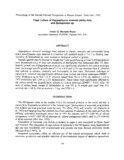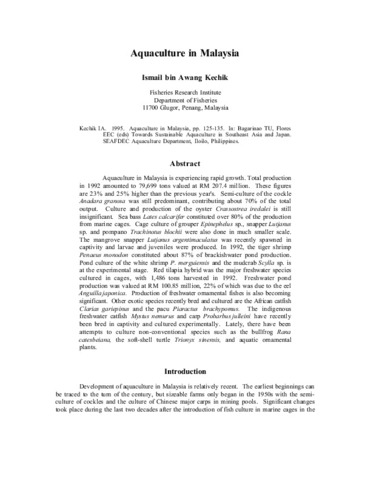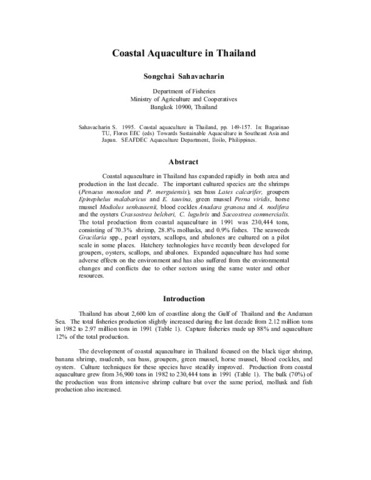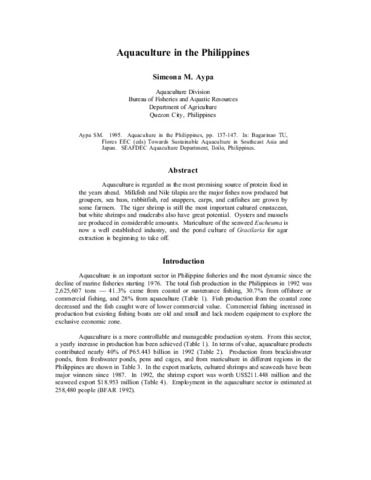Cage culture of Kappaphycus alvarezii (doty) doty and Epinephelus sp.
Share
Abstract
Kappaphycus alvarezii seedlings were cultured in cluster, vertically and horizontally using nylon monofilament rope attached to a bamboo raft installed inside a 5 x 5 m floating cage. Juveniles of Epinephelus sp. were stocked as biological control to grazers.
Specific growth rate (% increase in weight day-1) and production (g m-1 line-1) of Kappaphycus were determined every 45 days and production of Epinephelus was determined after 120 days. Specific growth rate of Kappaphycus alvarezii was significantly affected by the culture technique used. An average specific growth rate of 3.7 %, 3.8 % and 5.3 % was recorded when K alvarezii was cultured in clusters, vertically and horizontally in that order. Horizontal technique of culturing K alvarezii was significantly different from vertical and cluster techniques (DMRT = 0.05). Production (g m-1 line-1) of K. alvarezii ranged from 766 to 1,970, (in clusters), 1,110 to 1975 (vertically) and 1,204 to 1,533 (horizontally). These values were significantly affected by the culture month but insignificantly affected by culture technique (DMRT = 0.05). After 120 days of culture, mean weight of Epinephelus sp. was 297 g; % weight gain cage-1 was 233; survival rate = 68 %; fish production = 5 kg; and FCR = 6.
Suggested Citation
Hurtado-Ponce, A. Q. (1994). Cage culture of Kappaphycus alvarezii (doty) doty and Epinephelus sp. In P. M. Aliño (Ed.), Proceedings of the Second National Symposium in Marine Science, Mindanao State University, Tawi-Tawi, 5-7 November 1992 (pp. 103–108). Quezon City, Philippines: Marine Science Institute, University of the Philippines.
Subject
Collections
Related items
Showing items related by title, author, creator and subject.
-
Aquaculture in Malaysia
Kechik, Ismail bin Awang. (Aquaculture Department, Southeast Asian Fisheries Development Center, 1995)Aquaculture in Malaysia is experiencing rapid growth. Total production in 1992 amounted to 79,699 tons valued at RM 207.4 million. These figures are 23% and 25% higher than the previous year's. Semi-culture of the cockle ... -
Coastal aquaculture in Thailand
Sahavacharin, Songchai (Aquaculture Department, Southeast Asian Fisheries Development Center, 1995)Coastal aquaculture in Thailand has expanded rapidly in both area and production in the last decade. The important cultured species are the shrimps (Penaeus monodon and P. merguiensis), sea bass Lates calcarifer, groupers ... -
Aquaculture in the Philippines
Aypa, Simeona M. (Aquaculture Department, Southeast Asian Fisheries Development Center, 1995)Aquaculture is regarded as the most promising source of protein food in the years ahead. Milkfish and Nile tilapia are the major fishes now produced but groupers, sea bass, rabbitfish, red snappers, carps, and catfishes ...




